SEO
The 30 Most-Subscribed YouTube Individuals

MrBeast has just overtaken PewDiePie as the most-subscribed YouTube individual.
This is the first time in 10 years there’s been a change at the top of the most-subscribed YouTuber leaderboard.
It’s been a long way to individuals reaching 100 million subscribers.
On YouTube, way back in 2006, Judson Laipply was the first recorded individual to have the most subscribers, with mere thousands.
In the same year, Brookers was the first channel and individual to reach 10,000 subscribers – and that was a big deal.
Currently, the most-subscribed channel on YouTube is T-Series, an Indian record label and film studio.
T-Series was the first channel to reach 100 million subscribers in 2019 and the first to 200 million in 2021.
T-Series currently holds twice as many subscribers as the top individual YouTuber.
Being an influencer is big business.
This list has been compiled to provide a reference point of data and we report impartially on anyone included in the top 50 YouTube individuals list.
At Search Engine Journal, we are aware that some of the individuals included have a history of being divisive. We would like to make it clear that in no way do we support or endorse their behavior or beliefs.
Who Is The #1 Most Subscribed YouTuber?
As of December 2022, MrBeast is the most-subscribed YouTuber, with 116 million subscribers. PewDiePie is the second most popular with 111 million subscribers.
To celebrate reaching 100 million subscribers, MrBeast gave away a private island – which is probably a part of the reason he took the top position from PewDiePie.
The Top 50 Most-Subscribed YouTubers, December 2022
| Channel | Subscribers | Views | Videos | Language | |
| 1 | MrBeast | 116,000,000 | 19,263,779,296 | 731 | English |
| 2 | PewDiePie | 111,000,000 | 28,783,562,329 | 4,687 | English |
| 3 | Like Nastya | 102,000,000 | 85,894,111,041 | 738 | English |
| 4 | Justin Bieber | 70,600,000 | 29,324,935,875 | 249 | English |
| 5 | Marshmello | 56,100,000 | 13,873,454,613 | 404 | English |
| 6 | EminemMusic | 54,400,000 | 24,883,449,535 | 140 | English |
| 7 | Ed Sheeran | 52,700,000 | 28,695,696,678 | 258 | English |
| 8 | Ariana Grande | 52,100,000 | 22,802,079,830 | 146 | English |
| 9 | Taylor Swift | 50,400,000 | 27,275,211,507 | 203 | English |
| 10 | JuegaGerman | 46,800,000 | 14,016,556,814 | 2,005 | Spanish |
| 11 | Fernanfloo | 45,400,000 | 10,100,537,682 | 542 | Spanish |
| 12 | Felipe Neto | 44,700,000 | 15,997,572,787 | 4,030 | Portuguese |
| 13 | whinderssonnunes | 44,000,000 | 4,163,721,994 | 523 | Portuguese |
| 14 | Katy Perry | 43,600,000 | 24,481,039,418 | 120 | English |
| 15 | A4 | 42,900,000 | 18,972,838,307 | 693 | Russian |
| 16 | Alan Walker | 42,700,000 | 12,128,678,979 | 354 | English |
| 17 | Rihanna | 40,600,000 | 20,885,440,669 | 81 | English |
| 18 | elrubiusOMG | 40,400,000 | 7,540,181,708 | 708 | Spanish |
| 19 | Luisito Comunica | 39,700,000 | 8,072,644,879 | 1,186 | Spanish |
| 20 | Shakira | 39,100,000 | 24,959,673,730 | 306 | Portuguese |
| 21 | Kimberly Loaiza | 38,800,000 | 4,734,658,947 | 242 | Spanish |
| 22 | Luccas Neto | 38,400,000 | 21,150,514,052 | 1,928 | Portuguese |
| 23 | CarryMinati | 37,500,000 | 3,085,201,916 | 180 | Hindi |
| 24 | Daddy Yankee | 37,300,000 | 21,377,054,866 | 465 | Spanish |
| 25 | SHFA2 | 37,000,000 | 21,785,547,727 | 1,444 | Arabic |
| 26 | Mikecrack | 35,900,000 | 14,693,972,400 | 1,796 | Spanish |
| 27 | Total Gaming | 34,000,000 | 6,121,970,004 | 1,952 | Hindi |
| 28 | Markiplier | 34,000,000 | 19,268,236,775 | 5,364 | English |
| 29 | Ryan’s World | 33,800,000 | 53,182,901,784 | 2,271 | English |
| 30 | VEGETTA777 | 33,600,000 | 15,131,179,339 | 7,257 | Spanish |
Data source, December 2022.
Who Are The Top 12 Most-Subscribed YouTubers
The top 30 most-subscribed individuals features many successful music artists, but has a majority of native YouTube influencers.
With the channel becoming an integral part of marketing and distribution for music artists, it’s no surprise that top artists feature highly.
Justin Bieber (the top individual artist) leveraged YouTube from an early age to gain mainstream attention on his terms.
MrBeast has 40 million more subscribers than Bieber, which highlights just how much attention the channel can achieve – and that, today, being a YouTube influencer is being a celebrity.
To get a better understanding of who all the influencers are, we’ve included a summary of the top 12 most-subscribed YouTuber influencers below.
1. MrBeast
US-based Jimmy Donaldson started MrBeast as MrBeast6000 in 2012, when he was only 13.
He also holds 5 other channels, including Beast Reacts, MrBeast 2, Beast Philanthropy, and MrBeast 3 (inactive). MrBeast Gaming also sits in the top 30, with just under 30 million subscribers.
MrBeast early videos include counting to 10,000 non-stop (a 44-hour stunt) which quickly went viral, but is now best known for videos that involve elaborate stunts, charity donations, or cash giveaways. In one video he gave away $1 million.
Donaldson also features philanthropic stunt videos, such as “Giving A Random Homeless Man $10,000″ and “Gave $500,000 To Random People.”
Jimmy Donaldson’s net worth is estimated by Forbes to be around $500 million.
2. PewDiePie
PewDiePie, otherwise known as Felix Arvid Ulf Kjellberg, held the most-subscribed position on YouTube for nearly 10 years, until recently.
Swedish Kjellberg registered PewDiePie in 2010, and started out with play-by-plays of video games – a genre known as “Let’s Play.” It only took three years for him to be the most-subscribed channel on YouTube.
PewDiePie has also experimented with comedy, commentary, music, and shows. He is known for his signature “bro fist bump” at the end of videos.
He was also named the highest-earning YouTuber in 2016.
Kjellberg has released his own game and published a book.
3. Like Nastya
Anastasia Sergeyevna Radzinskaya is one of only a few child YouTubers on the list. Born in January 2014, she is the youngest influencer with the most followers.
Although Radzinskaya was born in Russia, she has since moved to the US and her videos are produced in English. The channel is for children and covers educational entertainment and vlogging.
Some of her success is down to the channel being dubbed in several languages enabling her to reach a wide audience.
Radzinskaya’s parents help her to manage the Like Nastya channel but she is the face and star of the show.
4. Justin Bieber
Canadian Justin Bieber is the musical artist with the most followers on YouTube. He joined YouTube in 2007 and after coming second in a local singing competition began posting himself performing song covers.
After his channel started to grow he got the attention of his now manager and his record label. In 2008, he signed a recording contract.
Bieber continued to focus on his YouTube channel and growing his followers – known as ‘Beliebers’. This most likely contributed to his early and continued success. He continues to post videos on YouTube alongside his music videos and promotional content.
5. Marshmello
American music artist and DJ Christopher Comstock also known as Marshmello joined YouTube in 2015.
For several years he kept his identity hidden under a marshmallow-type helmet. In 2017 when his identity was revealed, he said on Twitter: “I don’t take my helmet off because I don’t want or need fame. I’m genuinely trying to create something positive for people to connect with”.
The most popular videos on Comstock’s channel are music and lyric videos, he also posts cooking videos, how-tos, vlogs and films.
6. EminemMusic
Marshall Bruce Mathers III, known as Eminem, is an American rapper who first gained success in 1996. He is one of the most successful music artists of all time.
Mathers joined YouTube in 2007 to leverage the platform and mostly posts music and promotional content.
7. Ed Sheeran
Edward Christopher Sheeran MBE is a music artist from the UK. He first joined YouTube in 2006.
Sheeran began singing aged four and playing the guitar at 11, and in 2004, he independently recorded and released his music. In 2008 when he moved to London he would busk on the streets. In 2011, he began to gain traction until he became the successful and widely-known artist he is today.
On YouTube, his channel started to take off in 2017 when he reached 10 million subscribers. Since then his channel has escalated in popularity.
Sheeran’s channel is mostly music.
8. Ariana Grande
Ariana Grande-Butera is an American music artist and actress and began her dream of a music career aged eight.
Grande joined YouTube in 2007 and uploaded her first YouTube video, ‘Ain’t No Other Man’.
In 2008, Grande began performing professionally aged 15 in a Broadway musical and her fame grew as a TV actress.
In 2011, her cover songs on YouTube gained the attention of her record label and resulted in her being signed as a music artist.
Grande has gone on to be a highly-successful music artist and mostly posts music on YouTube.
9. Taylor Swift
Taylor Alison Swift is an American music artist. She pursued musical training from an early age, including acting and vocal training. She learned to play the guitar aged 12.
After moving to Nashville aged 14, Swift signed a recording contract aged 15 and quickly went on to achieve international fame.
Swift uses her YouTube channel for music, but has also posted a series of videos showing her personal life backstage.
10. JuegaGerman
Chilean Germán Alejandro Garmendia Aranis, also known as JuegaGerman, produces comedy videos about everyday life and Let’s Play videos in Spanish.
Garmendia peaked in 2015-2017 when he had the second most-subscribed channel behind PewDiePie.
Garmendia has three channels on YouTube:
- HolaSoyGerman, which he started first in 2011 and focused on comedy videos about everyday life.
- HolaSoyGerman2.
- JuegaGerman, which he started in 2013 as a Let’s Play video gaming channel.
11. Fernanfloo
Luis Fernando Flores Alvarado is a YouTuber from El Salvador under the channel name Fernafloo – a combination of Fernando and Flores.
Fernafloo is one of the most-subscribed Spanish-speaking channels, and the most subscribed in El Salvador.
Fernafloo was registered in 2011 when Alvarado was 18. He started out experimenting with tutorials and special effects videos before finding his niche with Let’s Play gaming-style videos.
Alvarado has appeared in a film, published a book, and was cast as a zombie in a video game.
12. FelipeNeto
Felipe Neto Rodrigues Vieira joined YouTube in 2006 as FelipeNeto, but didn’t post his first video until 2010. His content is focused on general entertainment.
Vieira is from Rio Janeiro in Brazil and became the first Brazilian to reach one million subscribers.
His Brother Luccas is also a YouTuber (ranked at 22).
TIME included Vieira in their 100 most influential people in the world list in 2020.
Following the success of his YouTube channel, Vieira has appeared in TV shows and been in advertising campaigns for big brands. He has also won numerous awards, including the “Favorite Male YouTuber” at the Brazilian Nickelodeon Kids’ Choice Awards.
Why YouTubers Are Significantly Influential For Online Marketers
Achieving a most-subscribed status on YouTube cements you as an influencer and enables you to make serious income.
Not only can YouTubers earn from ads on the videos, but they are also in demand as brand ambassadors for product placements, product reviews, and product collaborations.
Mere mentions of products and brands by an influencer can drive traffic and sales for brands. As seen by the impact of Ryan Kaji and his family, it can also influence an entire industry.
Smart influencers use the exposure to diversify into many mainstream areas of collaboration and business to supplement their income and ensure longevity.
Much like top-level sports stars have always been in demand as brand ambassadors, influencers can be used for brand alignment.
Influencer marketing is useful for online marketers to spread a message and reach a target audience. Influencers can be leveraged as part of specific campaigns, or to create hype around a product or brand.
Influencer marketing doesn’t have to be just for the big brands; influencers with only a few thousand engaged followers can help spread messages. And for smaller brands, elevated exposure on social media can be a major benefit.
More resources:
Featured Image:Arsenii Palivoda/Shutterstock
Historic YouTube subscribers data source (not including the current ranking table).
var s_trigger_pixel_load = false;
function s_trigger_pixel(){
if( !s_trigger_pixel_load ){
striggerEvent( ‘load2’ );
console.log(‘s_trigger_pix’);
}
s_trigger_pixel_load = true;
}
window.addEventListener( ‘cmpready’, s_trigger_pixel, false);
window.addEventListener( ‘load2’, function() {
if( sopp != ‘yes’ && !ss_u ){
!function(f,b,e,v,n,t,s)
{if(f.fbq)return;n=f.fbq=function(){n.callMethod?
n.callMethod.apply(n,arguments):n.queue.push(arguments)};
if(!f._fbq)f._fbq=n;n.push=n;n.loaded=!0;n.version=’2.0′;
n.queue=[];t=b.createElement(e);t.async=!0;
t.src=v;s=b.getElementsByTagName(e)[0];
s.parentNode.insertBefore(t,s)}(window,document,’script’,
‘https://connect.facebook.net/en_US/fbevents.js’);
if( typeof sopp !== “undefined” && sopp === ‘yes’ ){
fbq(‘dataProcessingOptions’, [‘LDU’], 1, 1000);
}else{
fbq(‘dataProcessingOptions’, []);
}
fbq(‘init’, ‘1321385257908563’);
fbq(‘track’, ‘PageView’);
fbq(‘trackSingle’, ‘1321385257908563’, ‘ViewContent’, {
content_name: ‘who-has-the-most-subscribers-on-youtube’,
content_category: ‘social youtube’
});
}
});
SEO
How to Find and Use Competitor Keywords

Competitor keywords are the keywords your rivals rank for in Google’s search results. They may rank organically or pay for Google Ads to rank in the paid results.
Knowing your competitors’ keywords is the easiest form of keyword research. If your competitors rank for or target particular keywords, it might be worth it for you to target them, too.
There is no way to see your competitors’ keywords without a tool like Ahrefs, which has a database of keywords and the sites that rank for them. As far as we know, Ahrefs has the biggest database of these keywords.
How to find all the keywords your competitor ranks for
- Go to Ahrefs’ Site Explorer
- Enter your competitor’s domain
- Go to the Organic keywords report
The report is sorted by traffic to show you the keywords sending your competitor the most visits. For example, Mailchimp gets most of its organic traffic from the keyword “mailchimp.”


Since you’re unlikely to rank for your competitor’s brand, you might want to exclude branded keywords from the report. You can do this by adding a Keyword > Doesn’t contain filter. In this example, we’ll filter out keywords containing “mailchimp” or any potential misspellings:


If you’re a new brand competing with one that’s established, you might also want to look for popular low-difficulty keywords. You can do this by setting the Volume filter to a minimum of 500 and the KD filter to a maximum of 10.


How to find keywords your competitor ranks for, but you don’t
- Go to Competitive Analysis
- Enter your domain in the This target doesn’t rank for section
- Enter your competitor’s domain in the But these competitors do section


Hit “Show keyword opportunities,” and you’ll see all the keywords your competitor ranks for, but you don’t.


You can also add a Volume and KD filter to find popular, low-difficulty keywords in this report.


How to find keywords multiple competitors rank for, but you don’t
- Go to Competitive Analysis
- Enter your domain in the This target doesn’t rank for section
- Enter the domains of multiple competitors in the But these competitors do section


You’ll see all the keywords that at least one of these competitors ranks for, but you don’t.


You can also narrow the list down to keywords that all competitors rank for. Click on the Competitors’ positions filter and choose All 3 competitors:


- Go to Ahrefs’ Site Explorer
- Enter your competitor’s domain
- Go to the Paid keywords report


This report shows you the keywords your competitors are targeting via Google Ads.
Since your competitor is paying for traffic from these keywords, it may indicate that they’re profitable for them—and could be for you, too.
You know what keywords your competitors are ranking for or bidding on. But what do you do with them? There are basically three options.
1. Create pages to target these keywords
You can only rank for keywords if you have content about them. So, the most straightforward thing you can do for competitors’ keywords you want to rank for is to create pages to target them.
However, before you do this, it’s worth clustering your competitor’s keywords by Parent Topic. This will group keywords that mean the same or similar things so you can target them all with one page.
Here’s how to do that:
- Export your competitor’s keywords, either from the Organic Keywords or Content Gap report
- Paste them into Keywords Explorer
- Click the “Clusters by Parent Topic” tab


For example, MailChimp ranks for keywords like “what is digital marketing” and “digital marketing definition.” These and many others get clustered under the Parent Topic of “digital marketing” because people searching for them are all looking for the same thing: a definition of digital marketing. You only need to create one page to potentially rank for all these keywords.


2. Optimize existing content by filling subtopics
You don’t always need to create new content to rank for competitors’ keywords. Sometimes, you can optimize the content you already have to rank for them.
How do you know which keywords you can do this for? Try this:
- Export your competitor’s keywords
- Paste them into Keywords Explorer
- Click the “Clusters by Parent Topic” tab
- Look for Parent Topics you already have content about
For example, if we analyze our competitor, we can see that seven keywords they rank for fall under the Parent Topic of “press release template.”


If we search our site, we see that we already have a page about this topic.


If we click the caret and check the keywords in the cluster, we see keywords like “press release example” and “press release format.”


To rank for the keywords in the cluster, we can probably optimize the page we already have by adding sections about the subtopics of “press release examples” and “press release format.”
3. Target these keywords with Google Ads
Paid keywords are the simplest—look through the report and see if there are any relevant keywords you might want to target, too.
For example, Mailchimp is bidding for the keyword “how to create a newsletter.”


If you’re ConvertKit, you may also want to target this keyword since it’s relevant.
If you decide to target the same keyword via Google Ads, you can hover over the magnifying glass to see the ads your competitor is using.


You can also see the landing page your competitor directs ad traffic to under the URL column.


Learn more
Check out more tutorials on how to do competitor keyword analysis:
SEO
Google Confirms Links Are Not That Important

Google’s Gary Illyes confirmed at a recent search marketing conference that Google needs very few links, adding to the growing body of evidence that publishers need to focus on other factors. Gary tweeted confirmation that he indeed say those words.
Background Of Links For Ranking
Links were discovered in the late 1990’s to be a good signal for search engines to use for validating how authoritative a website is and then Google discovered soon after that anchor text could be used to provide semantic signals about what a webpage was about.
One of the most important research papers was Authoritative Sources in a Hyperlinked Environment by Jon M. Kleinberg, published around 1998 (link to research paper at the end of the article). The main discovery of this research paper is that there is too many web pages and there was no objective way to filter search results for quality in order to rank web pages for a subjective idea of relevance.
The author of the research paper discovered that links could be used as an objective filter for authoritativeness.
Kleinberg wrote:
“To provide effective search methods under these conditions, one needs a way to filter, from among a huge collection of relevant pages, a small set of the most “authoritative” or ‘definitive’ ones.”
This is the most influential research paper on links because it kick-started more research on ways to use links beyond as an authority metric but as a subjective metric for relevance.
Objective is something factual. Subjective is something that’s closer to an opinion. The founders of Google discovered how to use the subjective opinions of the Internet as a relevance metric for what to rank in the search results.
What Larry Page and Sergey Brin discovered and shared in their research paper (The Anatomy of a Large-Scale Hypertextual Web Search Engine – link at end of this article) was that it was possible to harness the power of anchor text to determine the subjective opinion of relevance from actual humans. It was essentially crowdsourcing the opinions of millions of website expressed through the link structure between each webpage.
What Did Gary Illyes Say About Links In 2024?
At a recent search conference in Bulgaria, Google’s Gary Illyes made a comment about how Google doesn’t really need that many links and how Google has made links less important.
Patrick Stox tweeted about what he heard at the search conference:
” ‘We need very few links to rank pages… Over the years we’ve made links less important.’ @methode #serpconf2024″
Google’s Gary Illyes tweeted a confirmation of that statement:
“I shouldn’t have said that… I definitely shouldn’t have said that”
Why Links Matter Less
The initial state of anchor text when Google first used links for ranking purposes was absolutely non-spammy, which is why it was so useful. Hyperlinks were primarily used as a way to send traffic from one website to another website.
But by 2004 or 2005 Google was using statistical analysis to detect manipulated links, then around 2004 “powered-by” links in website footers stopped passing anchor text value, and by 2006 links close to the words “advertising” stopped passing link value, links from directories stopped passing ranking value and by 2012 Google deployed a massive link algorithm called Penguin that destroyed the rankings of likely millions of websites, many of which were using guest posting.
The link signal eventually became so bad that Google decided in 2019 to selectively use nofollow links for ranking purposes. Google’s Gary Illyes confirmed that the change to nofollow was made because of the link signal.
Google Explicitly Confirms That Links Matter Less
In 2023 Google’s Gary Illyes shared at a PubCon Austin that links were not even in the top 3 of ranking factors. Then in March 2024, coinciding with the March 2024 Core Algorithm Update, Google updated their spam policies documentation to downplay the importance of links for ranking purposes.
The documentation previously said:
“Google uses links as an important factor in determining the relevancy of web pages.”
The update to the documentation that mentioned links was updated to remove the word important.
Links are not just listed as just another factor:
“Google uses links as a factor in determining the relevancy of web pages.”
At the beginning of April Google’s John Mueller advised that there are more useful SEO activities to engage on than links.
Mueller explained:
“There are more important things for websites nowadays, and over-focusing on links will often result in you wasting your time doing things that don’t make your website better overall”
Finally, Gary Illyes explicitly said that Google needs very few links to rank webpages and confirmed it.
I shouldn’t have said that… I definitely shouldn’t have said that
— Gary 鯨理/경리 Illyes (so official, trust me) (@methode) April 19, 2024
Why Google Doesn’t Need Links
The reason why Google doesn’t need many links is likely because of the extent of AI and natural language undertanding that Google uses in their algorithms. Google must be highly confident in its algorithm to be able to explicitly say that they don’t need it.
Way back when Google implemented the nofollow into the algorithm there were many link builders who sold comment spam links who continued to lie that comment spam still worked. As someone who started link building at the very beginning of modern SEO (I was the moderator of the link building forum at the #1 SEO forum of that time), I can say with confidence that links have stopped playing much of a role in rankings beginning several years ago, which is why I stopped about five or six years ago.
Read the research papers
Authoritative Sources in a Hyperlinked Environment – Jon M. Kleinberg (PDF)
The Anatomy of a Large-Scale Hypertextual Web Search Engine
Featured Image by Shutterstock/RYO Alexandre
SEO
How to Become an SEO Lead (10 Tips That Advanced My Career)

A few years ago, I was an SEO Lead managing enterprise clients’ SEO campaigns. It’s a senior role and takes a lot of work to get there. So how can you do it, too?
In this article, I’ll share ten tips to help you climb the next rung in the SEO career ladder.
Helping new hires in the SEO team is important if you want to become an SEO Lead. It gives you the experience to develop your leadership skills, and you can also share your knowledge and help others learn and grow.
It demonstrates you can explain things well, provide helpful feedback, and improve the team’s standard of work. It shows you care about the team’s success, which is essential for leaders. Bosses look for someone who can do their work well and help everyone improve.
Here are some practical examples of things I did early in my career to help mentor junior members of the team that you can try as well:
- Hold “lunch and learn” sessions on topics related to SEO and share case studies of work you have done
- Create process documents for the junior members of the team to show them how to complete specific tasks related to your work
- Compile lists of your favorite tools and resources for junior members of the team
- Create onboarding documents for interns joining the company
Wouldn’t it be great if you could look at every single SEO Lead’s resume? Well, you already can. You can infer ~70% of any SEO’s resume by spying on their LinkedIn and social media channels.
Type “SEO Lead” into LinkedIn and see what you get.
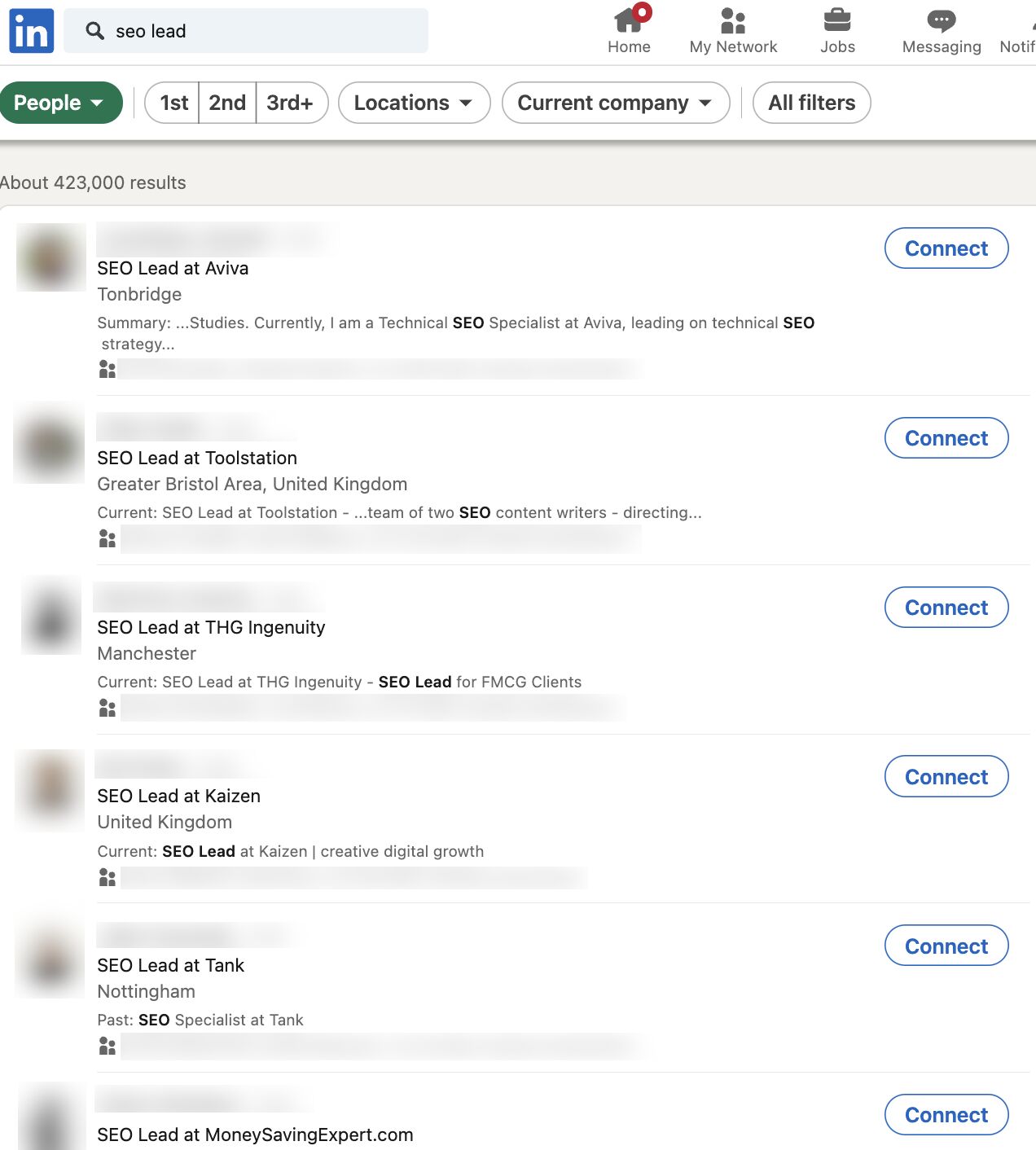
Tip
Look for common career patterns of the SEOs you admire in the industry.
I used this method to understand how my favorite SEOs and people at my company navigated their way from a junior role to a senior role.
For example, when the Head of SEO at the time Kirsty Hulse, joined my team, I added her on LinkedIn and realized that if I wanted to follow in her footsteps, I’d need to start by getting the role of SEO Manager to stand any possible chance of leading SEO campaigns like she was.
The progression in my company was from SEO Executive to Senior SEO Executive (Junior roles in London, UK), but as an outsider coming into the company, Kirsty showed me that it was possible to jump straight to SEO Manager given the right circumstances.


Using Kirsty’s and other SEOs’ profiles, I decided that the next step in my career needed to be SEO Manager, and at some point, I needed to get some experience with a bigger media agency so I could work my way up to leading an SEO campaign with bigger brands.
Sadly, you can’t just rock up to a monthly meeting and start leading a big brand SEO campaign. You’ll need to prove yourself to your line manager first. So how can you do this?
Here’s what I’d suggest you do:
- Create a strong track record with smaller companies.
- Obsessively share your wins with your company, so that senior management will already know you can deliver.
- At your performance review, tell your line manager that you want to work on bigger campaigns and take on more responsibility.
If there’s no hope of working with a big brand at your current job, you might need to consider looking for a new job where there is a recognizable brand. This was what I realized I needed to do if I wanted to get more experience.
Tip
Get recruiters on LinkedIn to give you the inside scoop on which brands or agencies are hiring. Ask them if you have any skill gaps on your resume that could prevent you from getting a job with these companies.
Being critical of your skill gaps can be hard to do. I found the best way to identify them early in my career was to ask other people—specifically recruiters. They had knowledge of the industry and were usually fairly honest as to what I needed to improve.
From this, I realized I lacked experience working with other teams—like PR, social, and development teams. As a junior SEO, your mind is focused 99% on doing SEO, but when you become more senior, your integration with other teams is important to your success.
For this reason, I’d suggest that aspiring SEO Leads should have a good working knowledge of how other teams outside of SEO operate. If you take the time to do this, it will pay dividends later in your career:
- If there are other teams in your company, ask if you can do some onboarding training with them.
- Get to know other team leads within your company and learn how they work.
- Take training courses to learn the fundamentals of other disciplines that complement SEO, such as Python, SQL, or content creation.
Sometimes, employers use skill gaps to pay you less, so it’s crucial to get the skills you need early on…


Examples of other skill gaps I’ve noticed include:
Tip
If you think you have a lot of skill gaps, then you can brush up your skills with our SEO academy. Once you’ve completed that, you can fast-track your knowledge by taking a course like Tom Critchlow’s SEO MBA, or you can try to develop these skills through your job.


As a junior in any company, it can be hard to get your voice heard amongst the senior crowd. Ten years ago, I shared my wins with the team in a weekly group email in the office.
Here’s what you should be sharing:
- Praise from 3rd parties, e.g. “the client said they are impressed with the work this month.”
- Successful performance insights, e.g “following our SEO change, the client has seen X% more conversions this month.”
- Examples of the work you led, e.g. if your leadership and decision-making led to good results, then you need to share it.
At Ahrefs I keep a “wins” document. It’s just a simple spreadsheet that lists feedback on the blog posts I’ve written, the links I’ve earned and what newsletters my post was included in. It’s useful to have a document like this so you have a record of your achievements.
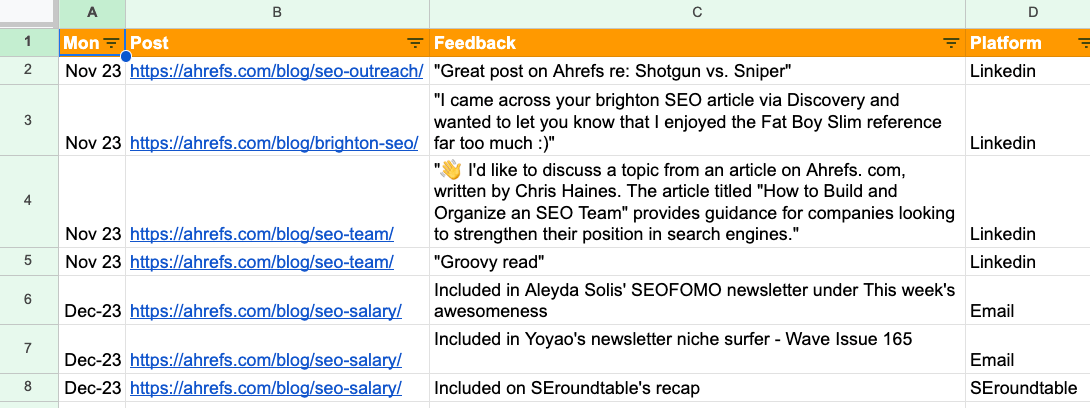

Sidenote.
Junior SEOs sometimes talk about the things “we” achieved as a team rather than what they achieved at the interview stage. If you want the SEO Lead role, remember to talk about what you achieved. While there’s no “I” in team, you also need to advocate for yourself.
One of my first big wins as an SEO was getting a link from an outreach campaign on Buzzfeed. When I went to Brighton SEO later that year and saw Matthew Howells-Barby sharing how he got a Buzzfeed link, I realized that this was not something everyone had done.
So when I did manage to become an SEO Lead, and my team won a prize in Publicis Groupe for our SEO performance, I made sure everyone knew about the work we did. I even wrote a case study on the work for Publicis Groupe’s intranet.
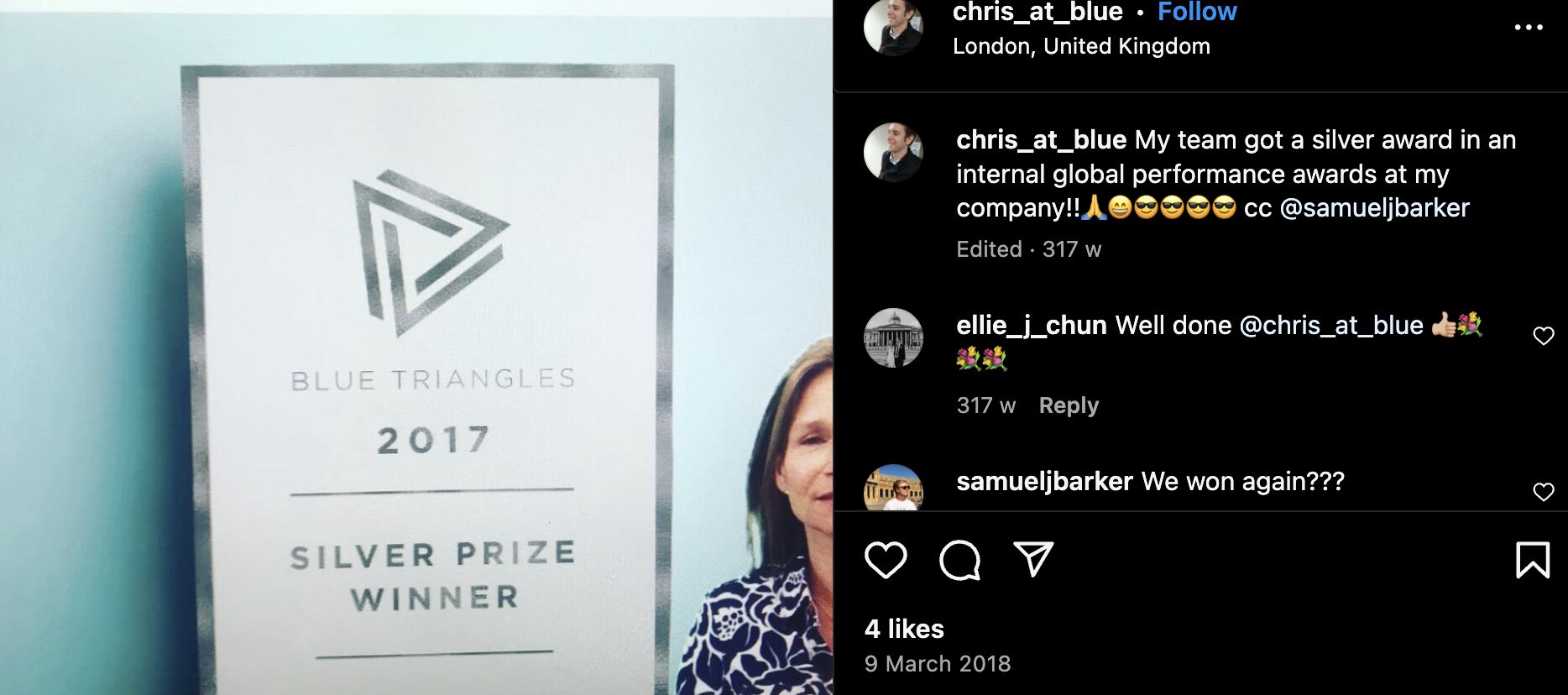

I’ve worked with some incredibly talented people, many of whom have helped me in my career.
I owe my big break to Tim Cripps, Laura Scott, and Kevin Mclaren. Without their support and encouragement, I wouldn’t be where I am today. Even before that, David Schulhof, Jodie Wheeler, and Carl Brooks let me mastermind some bonkers content campaigns that were lucky enough to succeed:


I wasn’t even an SEO Lead at that point, but they gave me the reins and trusted me.
So, how can you find your tribe?
- Speak to recruiters – they might hold the ticket to your next dream job. I spoke to many recruiters early in my career, but only two recruiters delivered for me—they were Natasha Woodford, and Amalia Gouta. Natasha helped me get a job that filled my skill gap, and Amalia helped me get my first SEO Lead role.
- Go to events and SEO conferences, and talk to speakers to build connections outside of your company.
- Use LinkedIn and other social media to interact with other companies or individuals that resonate with you.
Many senior SEO professionals spend most of their online lives on X and LinkedIn. If you’re not using them, you’re missing out on juicy opportunities.


Sharing your expertise on these platforms is one of the easiest ways to increase your chances of getting a senior SEO role. Because, believe it or not, sometimes a job offer can be just a DM away.
Here’s some specific ideas of what you can share:
- Share your thoughts on a trending topic – like the latest Google algorithm update.
- Share what you learned during the course of a campaign.
- Ask the community for their thoughts on a certain topic.
I’ve recently started posting on LinkedIn and am impressed by the reach you can get by posting infrequently on these topics.
Here’s an example of one of my posts where I asked the community for help researching an article I was writing:
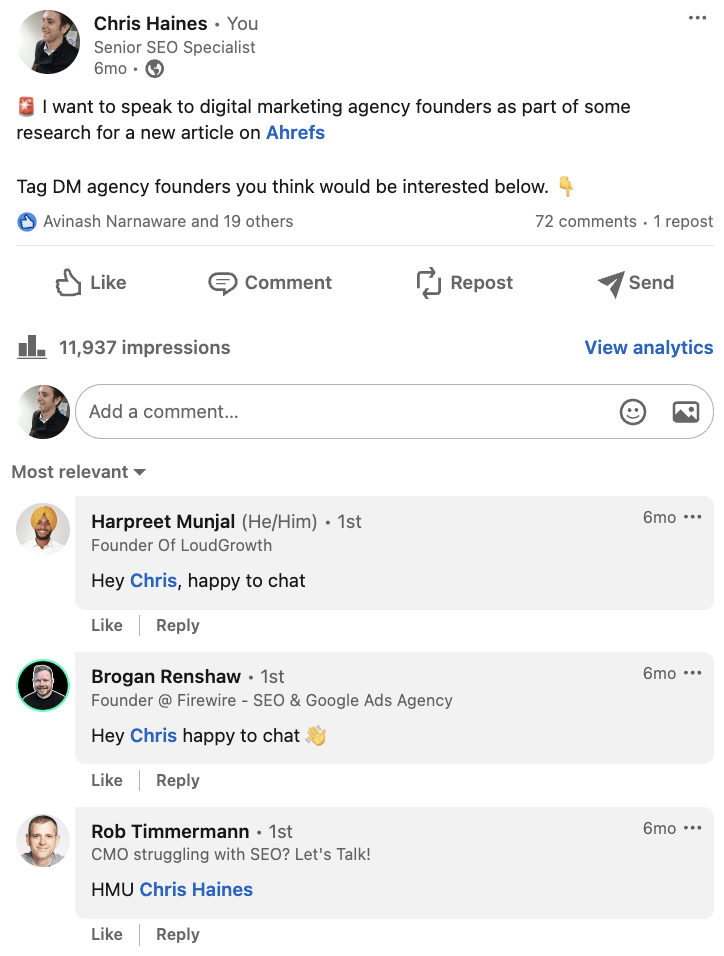

And here is the content performance across the last year from posting these updates.


I’m clearly not a LinkedIn expert—far from it! But as you can see, with just a few months of posting, you can start to make these platforms work for you.
Godard Abel, co-founder of G2, talked on a podcast about conscious leadership. This struck a chord with me recently as I realized that I had practiced some of the principles of conscious leadership—unconsciously.
You can start practicing conscious leadership by asking yourself if your actions are above or below the line. Here are a few examples of above and below-the-line thinking:
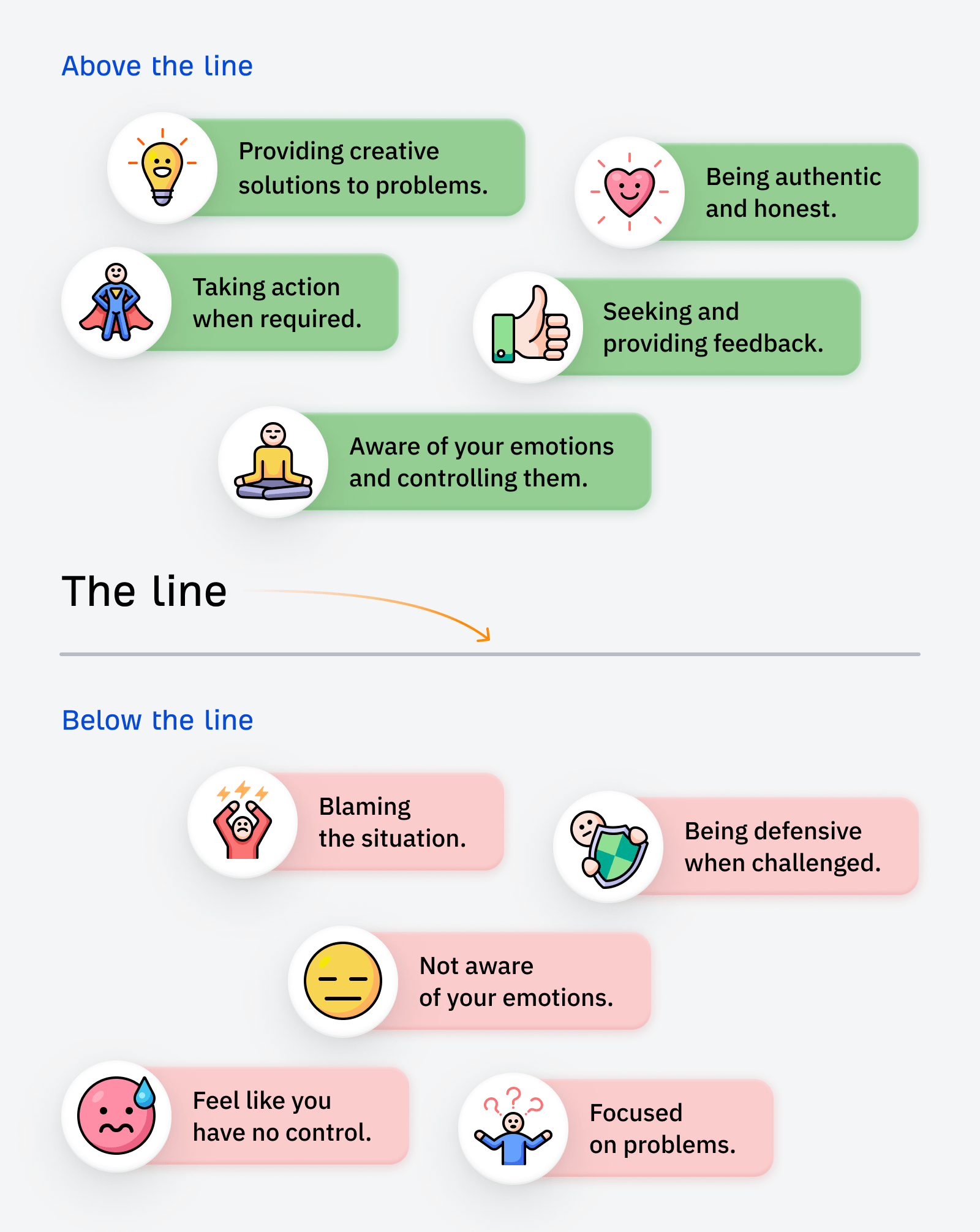

If you want a senior SEO role, I’d suggest shifting your mindset to above-the-line thinking.
In the world of SEO, it’s easy to blame all your search engine woes on Google. We’ve all been there. But a lot of the time, simple changes to your website can make a huge difference—it just takes a bit of effort to find them and make the changes.
SEO is not an exact science. Some stakeholders naturally get nervous if they sense you aren’t sure about what you’re saying. If you don’t get their support early on then you fall at the first hurdle.


To become more persuasive, try incorporating Aristotle’s three persuasive techniques into your conversations.
- Pathos: use logical reasoning, facts, and data to present water-tight arguments.
- Ethos: establish your credibility and ethics through results.
- Logos: make your reports tell a story.


Then sprinkle in language that has a high level of modality:


Some people will be able to do this naturally without even realizing it, but for others, it can be an uphill struggle. It wasn’t easy for me, and I had to learn to adapt the way I talked to stakeholders early on.
The strongest way I found was to appeal to emotions and back up with data from a platform like Ahrefs. Highlight what competitors have done in terms of SEO and the results they’ve earned from doing it.
Sidenote.
You don’t have to follow this tip to the letter, but being aware of these concepts means you’ll start to present more confident and persuasive arguments for justifying your SEO strategies.
When I started in SEO, I had zero connections. Getting a job felt like an impossible challenge.
Once I’d got my first SEO Lead job, it felt stupidly easy to get another one—just through connections I’d made along the way in my SEO journey.
I once got stuck on a delayed train with a senior member of staff, and he told me he was really into Google Local Guides, and he was on a certain high level. He said it took him a few years to get there.
Local Guides is part of Google Maps that allows you submit reviews and other user generated content
When he showed me the app, I realized that you could easily game the levels by uploading lots of photos.
In a “hold my beer” moment, I mass downloaded a bunch of photos, uploaded them to Local Guides and equaled his Local Guide level on the train in about half an hour. He was seething.


One of the photos I uploaded was a half-eaten Subway. It still amazes me that 50,974 people have seen this photo:
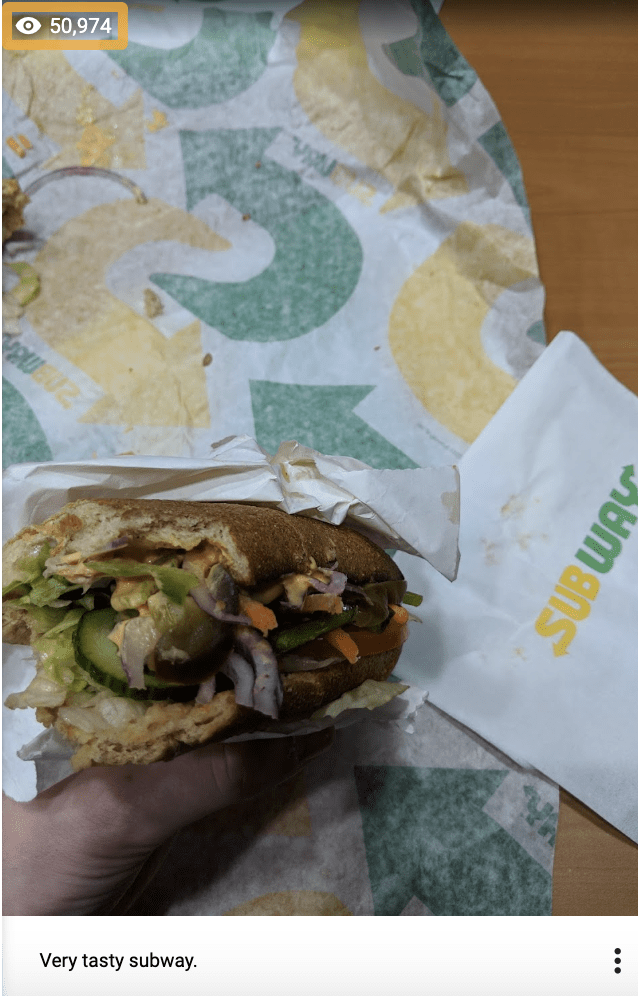

This wasn’t exactly SEO, but the ability to find this ‘hack’ so quickly impressed him, and we struck up a friendship.
The next month that person moved to another company, and then another few months later, he offered me an SEO Lead job.
Tip
Build connections with everyone you can—you never know who you might need to call on next.
Final thoughts
The road to becoming an SEO Lead seems straightforward enough when you start out, but it can quickly become long and winding.
But now armed with my tips, and a bucket load of determination, you should be able to navigate your way to an SEO Lead role much quicker than you think.
Lastly, if you want any more guidance, you can always ping me on LinkedIn. 🙂
-

 PPC4 days ago
PPC4 days ago19 Best SEO Tools in 2024 (For Every Use Case)
-

 PPC7 days ago
PPC7 days ago4 New Google Ads Performance Max Updates: What You Need to Know
-

 MARKETING7 days ago
MARKETING7 days agoWill Google Buy HubSpot? | Content Marketing Institute
-
SEARCHENGINES6 days ago
Daily Search Forum Recap: April 16, 2024
-

 SEO6 days ago
SEO6 days agoGoogle Clarifies Vacation Rental Structured Data
-

 MARKETING6 days ago
MARKETING6 days agoStreamlining Processes for Increased Efficiency and Results
-
SEARCHENGINES5 days ago
Daily Search Forum Recap: April 17, 2024
-

 PPC7 days ago
PPC7 days agoHow to Collect & Use Customer Data the Right (& Ethical) Way
















You must be logged in to post a comment Login